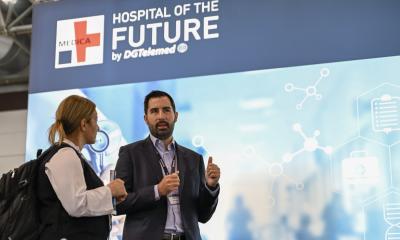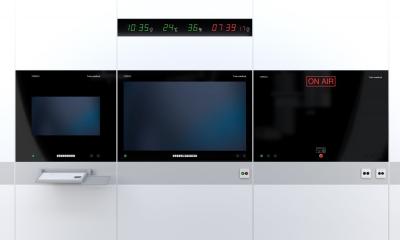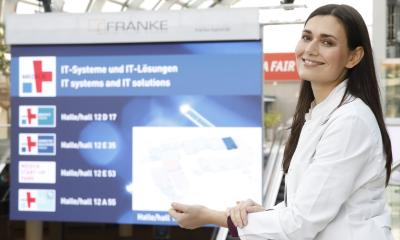Navigated Augmented Reality enhances medical applications
The digital world is being enriched by augmented reality (AR), which refers to any type of information offering the user additional help. Mostly, we don’t even notice it; the only external sign being Smart glasses. When new cars are launched we are always surprised by the constantly developing assistance systems they offer – and it’s the same for the growing number of smartphone apps.
Report: Anja Behringer

In the medical world, thanks to AR it is imaging procedures that are becoming ever more precise and helpful. In short: These days AR is an integral part of all kinds of navigation applications.
The International Symposium for Mixed and Augmented Reality (ISMAR) in Munich demonstrated how medical fields AR is utilised now and in the future.
The more precise the navigation must be, the more sophisticated the systems are. Therefore AR is primarily used in neurosurgery. AR may be just a simple reticule that the surgeon has to hold as precisely as possible above the target area of his intervention. In practice, AR is mainly implemented with conventional display technology because the current head-mounted displays still have a few ergonomic problems.
Austrian medical technology specialist Dr Bernhard Kainz, at London’s Imperial College, therefore believes that one of the future display technologies to be used in commercial products will be semi-transparent mirrors set between the operating field and the surgeon. ‘Display technology is a huge, distinct field, and ultimately it’s up to the user which type of technology will be accepted for which kind of application. Robot-assisted, minimally invasive interventions, which require stereoscopic, video-based display systems, are easier to augment than interventions that need little or no technology.’
Many ideas for desirable surgical aids are being developed worldwide, but converting them into actual products is mainly a financial issue. Therefore, AR is used for training in big universities. In practice, doctors use the existing technology creatively. As an example, Bernhard Kainz mentions the positioning laser in the CT or MRI Scanner, which is also often ‘misused’ to position needles or other instruments.
Although another method may be cheaper, this type of positioning is preferred because it helps the doctor with planning based on information from just one slice. Although this is not optimal, it is an application of AR that has developed naturally.
The perfect technology allowing us to follow the path of the instruments live, inside the patient, is still being developed.
‘These days, AR is used in neurosurgery navigation for minimally invasive interventions in simplified form, such as via reticule or as a visualisation for teaching purposes and, in the near future hopefully, also to overlay radiological image data for any kind of intervention with the real patient in such a way that AR is no longer even perceived as “specialist technology”,’ Kainz foresees.
The advantages are obvious: In the ideal case, the doctor has all information required at the right time and place and the patient is spared avoidable errors, higher radiation exposure and longer treatment times. Additionally, the technology improves the options for documentation and patient information.
The application of AR-assistance, like all new technologies, poses manifold challenges. From a human viewpoint, it is difficult when an engineering mind-set clashes with established medical technologies, as the benefit of new technology must outweigh the costs by far.
With the increased use of technology, patients often wonder if decisions are actually made by doctors or by technology. Most patients are not aware that most medical decisions are indeed taken algorithmically, based on many tests, because they cannot see these technologies. AR on the other hand is visible, and therefore these medical assistance systems must offer a great advantage compared to conventional treatment and diagnostic procedures if they are to become established as standard applications.
A small advantage, or a pure show effect, is nowhere near sufficient enough. As a positive example, Kainz mentions the C-Arch. The use of AR has made it possible to lower the exposure dose for patients by factor 40 during this procedure.
From a technical point of view the specialist still sees numerous challenges such as problems with imaging, reliable and precise position tracking or issues with data preparation- and visualisation. ‘In my view,’ he points out, ‘we currently need to invest a lot more into real-time imaging and visualisation, so that AR-systems can be utilised as naturally as possible.’
Users as well as developers see a particular potential in the use of cost-efficient and easy to implement enhancements such as 3D printers. Such systems have large benefits in practice. AR frequently also requires different types of camera, display and input technology that must be appropriately calibrated with one another. ‘This is best achieved with precisely designed but easy to reproduce components,’ says Kainz. ‘The 3D printer has facilitated a completely new kind of prototype visualisation. Not only does it enable the exchange of building plans for building components in the simplest way – i.e. via e-mail – but it also facilitates very simple and cost-effective enhancements for existing devices.’
PROFILE:
Bernhard Kainz, a Marie-Curie Fellow at Imperial College, London, is researching real-time imaging, interactive image processing and visualisation for foetal MRI, in Professor Daniel Rueckert’s Working Group. Earlier, he managed research projects on hardwareaccelerated algorithms and medical realtime visualisation at the Graz University of Technology in Austria, where he also wrote his dissertation on real-time volume visualisation, within a team
headed by Professor Dieter Schmalstieg. Dr Kainz’s research links medical image acquisition with fast, hardwareaccelerated algorithms to enable optimum diagnosis and intervention via interactive image processing and visualisation.
14.11.2014











